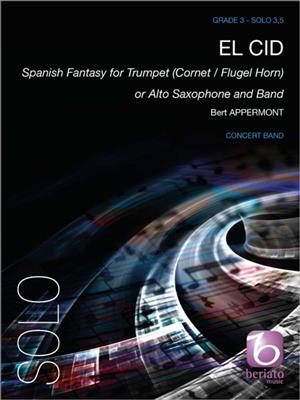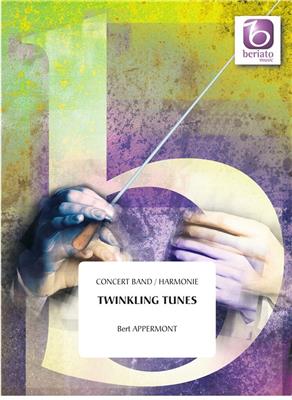Results
-
 £104.99
£104.99Aurum - Bert Appermont
The magnificent concert march Aurum (lat. gold) was written on the occasion of the 50th anniversary of the cunductor of the municipal band of Wolfach, in Baden-Wrttemberg, Germany. The march begins with a light and playful theme. The following lyrical trio provides a contrast, with its nod to Edward Elgar. After a number of key changes the introductory theme returns in canon. Finally, the music heads to a majestic finale, inwhich the trio theme is played as a splendid baroque chorale.
Estimated dispatch 7-14 working days
-
 £84.99
£84.99Return of the Vikings - Bert Appermont
This composition paints a picture of belligerent and brave Vikings. After a short introduction the lofty main theme is heard, accompanied by sombre drum sounds. A brief idyllic passage follows that evokes a beautiful landscape. Gradually, a heroicmelody is revealed, leading to a great tutti, in which the rousing main theme is heard once more. Return of the Vikings closes with the sound of heroic brass and festive chords.
Estimated dispatch 7-14 working days
-
 £137.99
£137.99El Cid - Bert Appermont
El Cid was the name of the legendary knight and folk hero Rodrigo D az de Vivar Cameador, the man who never lost a duel. After a typically Spanish opening, a slower section follows in which the composer makes reference to Albinoni'sAdagio and to the slow movement from Joaqu n Rodrigo's Concierto d'Aranjuez. The music is whipped up with Spanish passion at the close, and castanets are a must! The solo part can be played by trumpet, flugelhorn, cornet oralto saxophone and is also available in a simplified version.
Estimated dispatch 7-14 working days
-
 £137.99
£137.99Treasure Island - Bert Appermont
This composition was inspired by the adventure novel Treasure Island by the Scottish author Robert Louis Stevenson. The music does not recount the tale verbatim, but rather sketches particular events and moods in scenes.
Estimated dispatch 7-14 working days
-
 £76.99
£76.99Hymn of Glory - Bert Appermont
This melodic hymn begins with a lyrical melody, handled by various instrument groups. After a gradual build, a first climax is reached, in which the brass instruments give full vent to their glorious sound in jubilation. Now we hear a second theme,resounding in the euphoniums, which ushers in a moment of rest. Then the excitement gathers again, building to a great tutti. The main theme is taken up once more, sounding now as a kind of universal gratitude.
Estimated dispatch 7-14 working days
-
 £84.99
£84.99The Soldier & The Princess - Bert Appermont
This work is based on the story of the soldier and the princess from the film Cinema Paradiso. The story is about a poor soldier who fell in love with a beautiful princess. He had nothing to offer her, but he managed to meet her and declared his love for her. Do you want to know what happens next...?
Estimated dispatch 7-14 working days
-
 £159.99
£159.99In the Shadow of Napoleon - Bert Appermont
This suite is based on the musical In the Shadow of Napoleon which celebrated its exceptionally successful premire in Worms, Germany, on 21 July 2014. The musical tells the story of Louis-Joseph Marchand, Napoleon's footman who is involved in the dispute over the emperor's inheritance and the unsolved mystery of his death. The composer strove to present the six musical songs in the suite in such a way that it appears to be an entirely new work.
Estimated dispatch 7-14 working days
-
 £149.99
£149.99Jericho - Bert Appermont
Jericho is the musical translation of the well-known story from the book of Joshua about the capture of the city of Jericho by the Israelites.Part 1 depicts the cruel journey through the desert to Canaan, the promised land. An emotional lamentation for the yearning for a home, for the end of a roaming existence.The capture of Jericho is the theme of part 2. The city cannot be captured immediately and Jehovah orders an impressive army to march around the city for six days. On the seventh day, they marched around the city seven times and the priests blew their trumpets and the people cried so loud that the walls of Jericho came tumbling down. The Jews stormed the city and drove theinhabitants away. The music clearly reveals the marching army and you can hear the walls falling down with a tremendous noise. However, there is quite some artistic freedom in the actual story.A majestic and grand melody subsequently evokes the triumphant emotions that emerged as the fortified city fell (part 3).Following a personal and romantic interpretation, the scene ultimately ends in a typical Jewish feast (part 4) whereby the virtuosity of melodies played by the woodwinds and the passionate rhythms refer to traditional Jewish music. All themes are repeated in this last part in various forms, often simultaneous and in duelling counterpoint. The piece ends with fragments from the main theme of part 1 in major: peace and quiet return at last.
Estimated dispatch 7-14 working days
-
 £84.99
£84.99The Olympic Dream - Bert Appermont
Every athlete dreams of winning a medal at the Olympic Games: it's the ultimate dream. The mood of the games is indeed unique: stadiums filled to the brim, triumphant heroes, a sense of unity but often also of disappointment. These emotions are evoked in "The Olympic Dream" by a compelling and melodious theme that is repeated four times with varying accompaniment.
Estimated dispatch 7-14 working days
-
 £102.99
£102.99Twinkling Tunes - Bert Appermont
Twinkling Tunes are two original Christmas songs written especially for children and which, thanks to their flexible instrumentation, can be played by any wind band. Lichtjes van Kerstmis (Christmas Lights) is about people gathering together around the Christmas tree. The Lied der Koningen (Song of Kings) brings the story of the Magi to life. The vocal part (with Dutch text) is optional and can be performed either solo or by a children's choir, but even without vocals, this composition is sure to create a merry Christmas mood.
Estimated dispatch 7-14 working days
